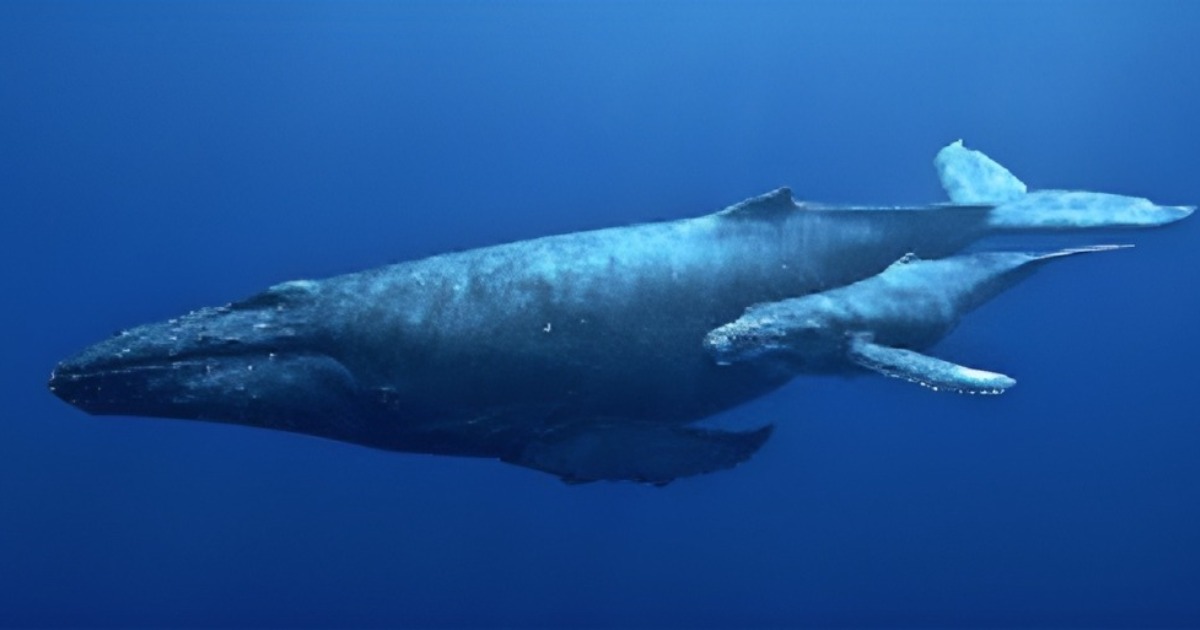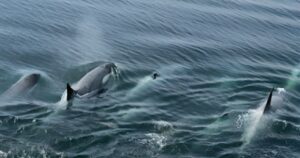Explosions from within ice traps, bone-destroying worms, and that’s only one percent of what the whales have to go through. If whales ever dreamed of becoming the largest and most invulnerable creatures on Earth, they made a major miscalculation. And no, we’re not discussing orcas, which are commonly mentioned in various whale videos. Curious to find out why being a whale isn’t as cool as it may appear?
Whenever it gets chilly outside, and the puddles freeze over, I can’t help but think about how the animals living in water bodies handle this situation. Just imagine getting stuck in the cold water. Even whales getting trapped by ice isn’t just an abstract fear for them; it’s a tough reality they face.
Generally, whales tend to avoid places that are completely frozen since they need to come up to the surface to catch a breath. However, some species stick around in areas that are only partially covered in ice if there’s a good amount of food available. In other words, they’re taking a risk with the chance of not making it.
Whales getting stuck in ice
There have been numerous recorded incidents of whales getting stuck in ice, with certain regions even earning the nickname “mammal traps.” One such area is found in the St. Lawrence Estuary off the Southeast coast of Newfoundland. Over 124 years, 40 whales have become caught in the ice there. Sadly, in 70 percent of cases, these incidents result in the death of the animals.
However, these traps don’t just appear randomly; they’re created by the wind. First, the wind breaks up the ice, allowing the whales to move and feed in previously inaccessible areas. Then, as the wind shifts direction, large chunks of ice can come together, forming traps.
For the whales, these traps can not only confine them to a small area but also cut off their access to oxygen. Back in 1988, there was a whale rescue mission that’s a great example. People actually had to saw through the ice to make a hole for the whales to breathe. As soon as the opening was there, the whales didn’t waste any time and started using it. This whole incident could easily be turned into a movie plot.
Lots of different whale species
Lots of different whale species are at risk due to ice. People usually think of orcas and beluga whales when they talk about ice and whales, but it’s not just them. Back in 2014, a bunch of endangered blue whales were found dead in the ice near the coast of Newfoundland. It’s likely that the ice actually crushed them, all nine of them.
The geographical location of the area means that strong winds from the East can push ice from the Strait of Belle Isle away from the shore and into the open water. This creates a path that the whales can use to swim and find food. Blue whales regularly go there to feed during the spring, so they don’t usually feel like they’re in danger. When a West wind picks up, it actually pushes the ice towards the shore, causing the ice to crush the whales before they can react. Although blue whales are skilled at navigating through the ice, luck wasn’t on their side in 2014. Later on, sperm whales were spotted in the region, and they probably died for the same reason. And those are just the deaths that have been recorded; now, imagine how many we don’t even know about.
But the whales’ concerns don’t end there. In fact, you probably already guessed it as the video’s just begun.
So some time ago, we talked about flies that, after human intervention, could consume so much food that they literally burst. But can the same happen to another animal without any human involvement? Well, turns out it can. Whales can face this unfortunate scenario. It’s no secret that whales ingest all sorts of human garbage while feeding. However, more recently, it was discovered that in certain isolated cases, this ingestion can lead to their stomachs rupturing, literally. When whales leave the ocean
Accumulation of garbage inside their stomachs
The accumulation of garbage inside their stomachs reaches alarming levels, and the whales are unable to digest or expel it in any other way. Meanwhile, the whales need to continue feeding to survive, resulting in their stomach volumes gradually increasing. Well, it’s quite obvious what happens next.
Back in 2018, they discovered a whale that had gobbled up nearly 66 pounds of plastic. Then, in 2008, another whale couldn’t find enough food and starved to death because it had swallowed over 154 pounds of garbage, leaving no space for a meal in its stomach. However, the most outrageous case came to light more recently in 2022. A sperm whale stranded in Nova Scotia had a whopping 330 pounds of trash in its belly. Now, let’s take a look at what can be found inside an average whale with a stomach that’s about to burst, and trust me, it’s not a pleasant sight. I won’t even attempt to describe the smell for you.
While it’s estimated that a sperm whale’s stomach can hold around 660 pounds of food, filling half of that space with garbage sounds like way too much.
Bone-eating worms,
Now, let’s talk about bone-eating worms because while the pollution of the world’s oceans and its consequences are more or less understood, bone-eating worms are much more intriguing. The ocean floor is home to some truly bizarre creatures, and Osedax worms are among the most peculiar. These bristle worms lack eyes and mouths, yet they manage to feed on the bones of deceased whales.
These worms begin their lives as tiny larvae drifting in the deep ocean. When they come across a deceased animal like a whale or a sea elephant, they settle on its bones. From there, the worms grow, resembling either miniature trees or remarkably beautiful corals. It’s actually quite simple; one end of the worm features root-like structures that grow into the bone. Scientists believe that the bacteria in these roots break down bone proteins, providing nutrients for the worm. On the other end, nature has designed feather-like appendages known as palps that absorb oxygen.
These worms were first documented by scientists approximately 20 years ago when they stumbled upon a whale carcass resting on the sea floor off the coast of California. The sunken skeleton was teeming with these tiny worms. Then, scientists had one scary thought: the worms seemed to have originated on Earth 45 million years ago, which is about the time that large whales first appeared in the fossil record. Although whales die quite rarely, these worms are very common in the ocean. They’re just about everywhere, which means they must be eating something other than whale bones. What exactly is on the menu of these worms? Scientists do not yet know. Maybe someone else’s tasty bones?
Now, let’s talk about parasites.
The good news for whales is that worms are only interested in them after they die. The bad news is that in addition to worms, there are many parasites living in the ocean, and cetaceans are particularly susceptible to some of them. Toothed whales are particularly affected by the parasite Nasotrema sp. Sometimes this parasite even goes straight to the brain, causing serious damage. There, the creature can also affect the heart, lungs, intestines, liver, and other organs, and it’s not only nasty but potentially dangerous. But how can tiny microorganisms even harm a huge animal like a whale? Well, like all other small creatures, their strength lies in numbers. These parasites lay over ten thousand eggs a day, causing significant damage to tissues. They also produce toxic waste that only makes things worse.
There are many photos on the internet of whale entrails that are literally bursting from these parasites. The infection is transmitted from mother to calf immediately through milk, and it’s usually even harder for calves to cope with parasites than adults. When parasites damage the brain, whales can completely lose orientation in space, and this is one of the reasons why they get stranded on the shore. Yes, that’s all because of the tiny creatures inside. If we take a more general perspective, it’s quite remarkable how much whales share with zombie ants that are under the control of a fungus, even though they’re quite different in size.
Narwhal
Meanwhile, narwhals experience a unique challenge within their own bodies. When they get scared, in response to fear, their heart rate drops significantly, but at the same time, they kick into high gear and swim faster to escape danger. Instead of beating around 60 times a minute, their heart only beats three or four times. You can probably guess what happens next; in a stressful situation with a limited blood supply, scientists tracking the narwhal’s heartbeats got graphs like these, with periods of stress highlighted in red.
Researchers are thinking that the drop in heart rate might be the reason why some whales end up stranded on beaches. When animals dash away from danger but have a really slow heart rate, their brains might not get enough oxygen, confusing them. And if their brain doesn’t get the right oxygen levels for too long, it could cause irreversible damage. It’s like these creatures have a sort of odd and not very efficient design. Any big pressure could really give them a hard time. But narwhals haven’t vanished; they’ve somehow found ways to adjust their life, which might not be all that enjoyable, though.
Sad songs of Humpback Whales
The strangest and even somewhat human-like fear of cetaceans is the fear of being alone. A study suggests that the sad songs sung by humpback whales might actually be a way of showing their loneliness. And if you’ve ever heard these songs, you’d probably agree that they sound really sad, well, maybe even a bit creepy. Back in the 1970s, scientists started hearing and studying the intricate songs of humpback whales thanks to these new underwater microphones. Interestingly, it’s only the male whales that sing, and it’s thought that their tunes help them attract mates, that’s how they establish their dominance too.
The interesting thing is that when whale numbers shot up after they stopped commercial whaling, the whales actually started singing less often. A little earlier before this whole recovery effort, experts observed the following pattern: the dramatic decline in whale numbers in the world’s oceans was causing the remaining creatures to suffer from loneliness and lose the will to live. The whales were literally mourning. Whales require a significant population to reproduce successfully; otherwise, the species might experience a sense of sadness, leading them to sing loudly with a melancholic tone and eventually cease breeding due to grief and a lack of social interactions.
The notion of whales grappling with loneliness has given rise to a captivating legend surrounding the loneliest whale worldwide. This legend is rooted in a remarkable event from 1989 when hidden sensors captured a distinctive sound.
Melodic patterns of typical whale songs
The sound bore a resemblance to the melodic patterns of typical whale songs but registered at an unexpectedly high frequency of 52 Hertz. This was particularly baffling since blue whales usually communicate within the 15 to 20 Hertz range. After analyzing the enigmatic sound, experts concluded that it belonged to the loneliest whale in the world. It seemed that something was causing this whale to sing at a frequency too high for anyone to hear. The whale was reaching out to someone, but its calls went unanswered by its fellow whales.
The story gained massive attention online, leading to the creation of a Kickstarter campaign aimed at locating the lonely whale. However, researchers eventually changed their minds. They realized that the frequency chosen by the whale wasn’t as unusual as initially believed. As time passed, scientists uncovered various types of whale songs, discovering that animals from different regions had their own unique dialects. With this in mind, a 52 Hertz whale wasn’t an exceptional phenomenon. Simply put, the whale was just singing with a strong accent, and people didn’t realize it right away. But they felt sorry for him, just in case.
Knowing about the melancholic tunes and remarkable intelligence of whales, scientists began to wonder whether these creatures could truly experience grief. For a while, this remained a mystery because, well, whales can’t shed tears and lack the facial muscles for emotional expressions. Imagine trying to grasp the emotions of such massive beings.
Dolphins and various whale species can grieve
However, thanks to modern technology, we now have an answer: yes, dolphins and various whale species are indeed capable of grieving. They feel the same emotions as humans when they lose their loved ones. Grief often arises from the death of group members, particularly their offspring. As these animals mourn their deceased, researchers have noted that they spend extended periods near the bodies, showing signs of sadness. In essence, they behave much like people who, after losing a loved one, frequently visit their final resting place.
For example, a researcher from the Smithsonian Institution reported that after the death of a companion, captive bottlenose dolphins lay at the bottom of a pool and clearly showed signs of depressive behavior. Humpback whales are also known to weep and grieve for a mate who got stranded. A truly heartbreaking experience for scientists was watching an orca that poked and sniffed its dead calf for six hours after its death.
In some cases, animals even guard the dead, ignoring their own well-being and safety. They continue to protect the dead family member or friend, even though this is pointless. Dolphins actually make up about 92.8 percent of cases where grieving behavior is observed. But there are also instances of similar behavior among other creatures, like humpback whales and orcas.
Grieving requires a big brain
Grieving requires a big brain, and dolphins have the biggest brain relative to their body size. Of course, if you were a whale, you’d be afraid of losing your friends. Just think about it: how would you even move? How would you eat or breathe? There’s this whale that they say had its hind fins sliced off by a propeller. They spotted it swimming near the coast of Italy. The massive 62-foot long whale looked exhausted and couldn’t even dive to catch the two tons of krill it needs every day.
Kodamoza – The whale with the chopped tail
The whale with the chopped tail, known as Kodamoza, was first spotted back in 1996 in the Ligurian Sea, already missing half of its tail fin. It was easy to spot because, unlike other whales, this one had to lift its tail out of the water to dive. For the next 24 years, Kodamoza continued to make occasional appearances in the Mediterranean Sea. However, in 2020, a catastrophe occurred off the coast of France when Kodamoza was spotted without the remaining half of its tail. A tailless whale faces significant challenges, as swimming becomes an energy drain, and hunting without those fins becomes much more challenging. Unfortunately, there’s no information about the fate of Kodamoza, but it’s likely that it met a sad end.
In addition to individual challenges faced by whales like Kodamoza, they also encounter tougher times due to factors such as human activities and orca predation.
Whale Graveyard
There’s also the concept of a “whale graveyard,” such as the one found under pack ice in a cove near the town of Tasiusaq in Greenland. Local Inuit hunters gather whale carcasses and strip them down to the bone. When the tide comes in, they toss the bones back into the water, creating a real whale graveyard under the ice.
Furthermore, scientists are working on deciphering the potential language of sperm whales. Sperm whales produce a set of sounds that might be intricate enough to qualify as a language. They have complex social structures and spend most of their time communicating. Understanding their language involves analyzing a vast amount of data, which is currently being collected and analyzed with the help of artificial intelligence. The process requires a significant amount of time and data collection effort, but scientists are willing to invest the time to understand these magnificent creatures better.



